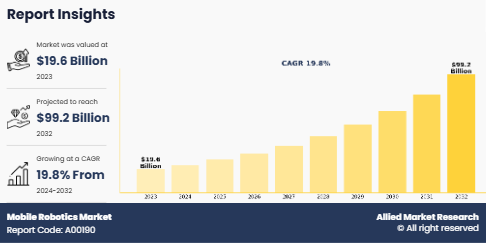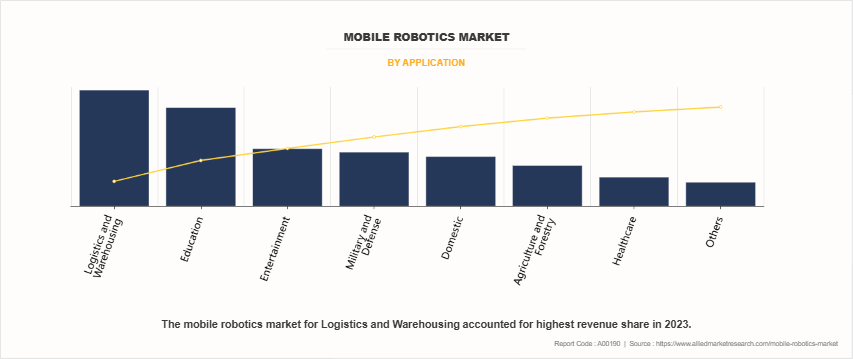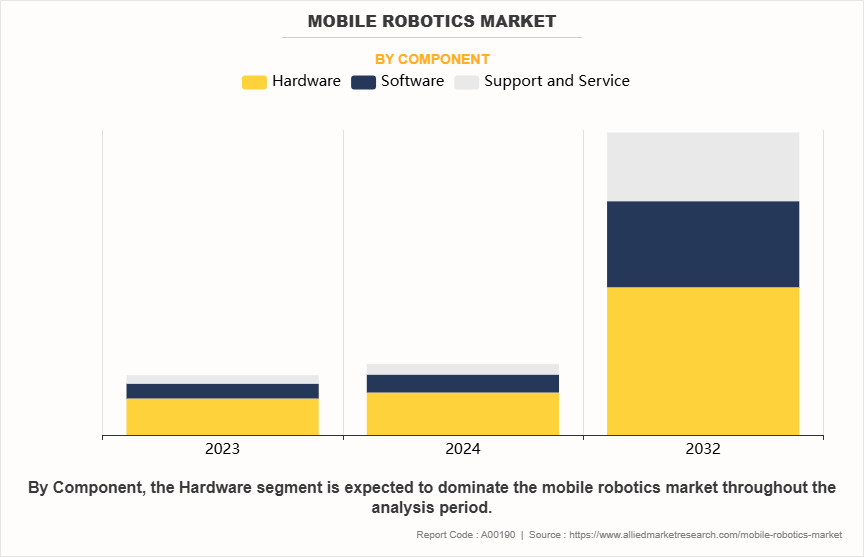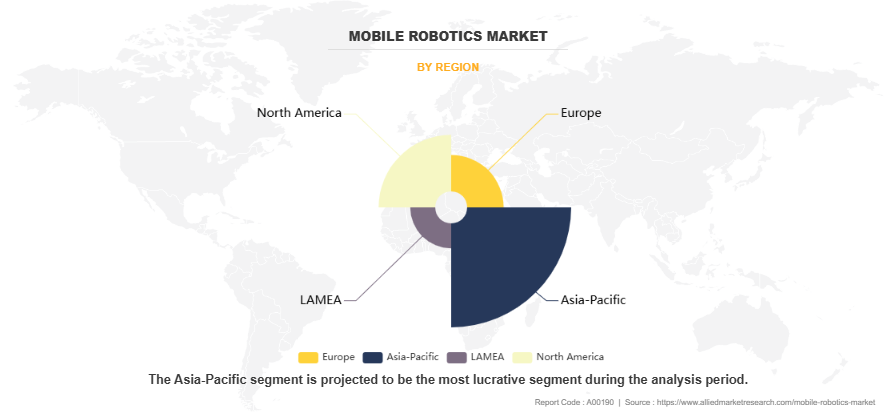Mobile Robotics Market
P
2024
Mobile Robotics Market Size, Share, Competitive Landscape and Trend Analysis Report, by Application, by Product, by Component : Global Opportunity Analysis and Industry Forecast, 2024-2032
Mobile Robotics Market Research, 2032
The global mobile robotics market was valued at $19.6 billion in 2023, and is projected to reach $99.2 billion by 2032, growing at a CAGR of 19.8% from 2024 to 2032.

Mobile robotics is the branch of science and technology, wherein developers create mobile robots that are capable of moving in a physical environment. These robots possess the capability to move in any environment without the need of human intervention. Devices such as sensors, software, and other gears are used to control these robots. Robotic technology such as unmanned ground vehicles, unmanned aerial vehicles, and autonomous underwater vehicles are taken into consideration while studying mobile robotics under various industry verticals.
The robotic technology is witnessing increased adoption in various commercial and industrial settings. For example, hospitals are now using autonomous mobile robots to move materials and track patient health. The military & defense sector uses professional service robots, which are deployed for combat scenarios. Moreover, mobile robotics enhance the soldier’s capabilities by giving troops an advantage at the ground level. In addition, field robot, a professional service robot, is used in this sector for a variety of functions such as carrying heavy equipment, operating in life-threating situations to protect soldiers, and rescuing wounded soldiers in combat zones.
Advancements in technology, including artificial intelligence (AI), machine learning, sensors, and computer vision, significantly impact mobile robotics by enhancing navigation, perception, and decision-making. The integration of these technologies leads to more sophisticated and adaptable robotic systems, aligning with the evolving needs of diverse industries.
Surge in the mobile robotics Industry is primarily fueled by growing industry demand for operational automation, efficiency, and adaptability. Key factors driving this trend include the increasing embrace of autonomous vehicles, advancements in artificial intelligence and sensor technologies, and the imperative for efficient logistics and warehouse management. The mobile robotics Industry also experiences growth through applications in healthcare, agriculture, and manufacturing. Organizations are propelled by the objectives of cost reduction, enhanced productivity, and continuous development of advanced robotic solutions, further propelling the mobile robotics market, as companies actively seek innovative approaches to elevate their operational efficiencies.
Key Takeways:
- On the basis of application, the logistics and warehousing segment dominated the mobile robotics market size in terms of revenue in 2023 and is anticipated to grow at the fastest CAGR during the forecast period.
- On the basis of product, the unmanned aerial vehicle (UAV) segment dominated the mobile robotics market forecast in terms of revenue in 2023. However, the Unmanned Ground Vehicle (UGV) segment is anticipated to grow at the fastest CAGR during the forecast period.
- On the basis of component, the hardware segment dominated the mobile robotics market outlook in terms of revenue in 2023. However, the support and service segment is anticipated to grow at the fastest CAGR during the forecast period
- Region-wise, North America generated the largest revenue in 2022. However, Asia-Pacific is anticipated to grow at the highest CAGR during the forecast period.
Mobile robotics involves designing, building, operating, and employing robots capable of autonomous or semi-autonomous movement in diverse environments. Equipped with mobility features, these robots navigate and execute tasks in dynamic surroundings. Mobile robotics integrates mechanical and electrical engineering, computer science, and artificial intelligence to craft machines capable of self-directed movement and decision-making.
These robots commonly employ sensors, actuators, and advanced algorithms to perceive their surroundings, make decisions, and adapt to changing conditions. Applications of mobile robotics are widespread, spanning industries such as logistics, manufacturing, healthcare, agriculture, and defense. They are pivotal in automating tasks, enhancing efficiency, and addressing challenges in intricate and changing environments, contributing to technological advancements and reshaping operational paradigms across various sectors.
Market Dynamics
Advancements in technology, including artificial intelligence (AI), machine learning, sensors, and computer vision, significantly impact mobile robotics by enhancing navigation, perception, and decision-making. The integration of these technologies leads to more sophisticated and adaptable robotic systems, aligning with the evolving needs of diverse industries.
A major driver for the mobile robotics market is rise in demand for automation across sectors. Industries aim to enhance operational efficiency, cut costs, and boost overall productivity through the deployment of mobile robots. Applications vary from autonomous vehicles in logistics to robot-assisted surgery in healthcare, indicating the widespread adoption of automated solutions.
Mobile robotics demonstrates versatility across logistics, manufacturing, healthcare, agriculture, and defense. Each sector's specific requirements contribute to a broad market base. Recognizing the benefits of automation, industries increasingly demand specialized robots tailored to unique tasks, contributing to market expansion.
The logistics and warehousing sector emerges as a key driver, utilizing automated guided vehicles (AGVs) and autonomous mobile robots (AMRs) for material handling, inventory management, and order fulfillment. The growing e-commerce and supply chain operations amplify the need for efficient and flexible robotic solutions in logistics. In healthcare, mobile robotics plays diverse roles, including telepresence, patient assistance, and surgery. Robot-assisted surgeries gain prominence for precision improvement and reduced recovery times. The aging population and the demand for enhanced healthcare services further drive the growth of mobile robotics in healthcare.
Mobile robots are integral to manufacturing tasks like material handling, assembly, and inspection. Collaborative robots (cobots) working alongside humans enhance efficiency and ensure safer work environments. The push for smart factories and Industry 4.0 accelerates the integration of mobile robotics in manufacturing.
The agriculture sector witnesses increased adoption of mobile robotics for precision farming, crop monitoring, and harvesting. AI-equipped agricultural robots enhance efficiency, reduce resource usage, and improve crop yields, addressing challenges in modern farming practices.
The regulatory environment significantly influences the mobile robotics market, with compliance to safety standards, data privacy regulations, and industry-specific requirements impacting the development and deployment of robotic systems. Adapting to evolving regulatory frameworks is essential for market acceptance.
Investments and funding underscore the industry's growth potential, with venture capital, government initiatives, and strategic partnerships contributing to research and development, fostering innovation and introducing new robotic solutions to the market. Despite a growth trajectory, the mobile robotics market faces challenges such as high initial costs, concerns about job displacement, and the need for standardized interfaces. Effectively addressing these challenges is crucial to ensure sustained market expansion and widespread acceptance of mobile robotics solutions.
Segmental Overview
The mobile robotics market is segmented into application, product, component, and region.

On the basis of application, the market is divided into logistics and warehousing, military and defense, healthcare, domestic, entertainment, education, agriculture and forestry, and others. In 2023, the logistics and warehousing segment dominated the market, and the domestic segment is expected to acquire a major market share by 2032 owing to increase in use of floor cleaning robots for retail and residential end users.

On the basis of product, the market is categorized into unmanned ground vehicle (UGV), unmanned aerial vehicle (UAV), and autonomous underwater vehicle (AUV). In 2023, the Unmanned Aerial Vehicle (UAV) segment dominated the market, and it is expected to acquire a major market share by 2032 due to increase in investment of government and private companies on public transports, healthcare support, and other vital sectors.

On the basis of component, the market is divided into hardware, software, and support and service. In 2023, the hardware segment dominated the market, and the support and service segment is expected to acquire a major market share by 2032 owing to increase in sales of mobile robotics for various sectors.

On the basis of region, the mobile robotics market trends are analyzed across North America (the U.S., Canada, and Mexico), Europe (Germany, UK, France, Spain, Italy, and rest of Europe), Asia-Pacific (China, Japan, India, South Korea, and rest of Asia-Pacific), Latin America (Brazil, Argentina, and Rest of Latin America), and Middle East and Africa (Saudi Arabia, Africa, and Rest of Middle East And Africa).
Competitive Analysis
Competitive analysis and profiles of the major global Mobile robotics market players that have been provided in the report include Kuka AG., Honda Motor Co., Ltd., Northrop Grumman Corporation, iRobot Corporation, Lockheed Martin Corporation, SoftBank Robotics Holdings, Amazon Robotics, Kongsberg Maritime AS, UBTECH Robotics, Inc., and Boston Dynamics. The key strategy adopted by the major players of the mobile robotics market are acquisition and partnership.
Country Analysis
Country-wise, Canada acquired a prime share in the mobile robotics market in the North America region and is expected to grow at a significant CAGR during the forecast period.
In Europe, Germany dominated the mobile robotics market share, in terms of revenue in 2023 and is expected to follow the same trend during the forecast period. Germany is expected to emerge as the fastest-growing country in the Europe mobile robotics market with a CAGR of 21.7% during the forecast period.
In Asia-Pacific, China is expected to emerge as significant market for the mobile robotics market industry, owing to nation's rapid industrialization, substantial investments in automation technologies, and a growing emphasis on enhancing manufacturing efficiency and innovation.
In LAMEA, Middle East has a significant market share in 2023. The LAMEA mobile robotics market growth is attributed to increased investments in the region for mobile robotics market.
Recent Acquisition in Mobile Robotics Market
- In January 2022, Aptiv announced its acquisition of Wind River company for $4.3 billion. Aptiv company said the acquisition allows it to execute against the large software-defined mobility opportunity and expand into multiple industries. Aptiv mentioned that it will combine Wind River Studio, a cloud-native intelligent systems software platform, with its SVA platform and automotive expertise.
- In March 2022, Sarcos Technology and Robotics Corporation announced the acquisition of RE2 Robotics, a Pittsburgh-based developer of autonomous and teleoperated mobile robotic systems, for $100 million. The deal consists of $30 million in cash and $70 million of Sarcos common stock. Both companies have had long-term success with military and defense customers.
Recent Partnership in Mobile Robotics Market
- In December 2023, XtalPi and ABB Robotics announced a strategic partnership to produce automated laboratory workstations in China. The companies said that ABB’s GoFa collaborative robots and XtalPi’s software will boost research and development productivity in biopharmaceuticals, chemical engineering and chemistry, and new-energy materials.
Top Impacting Factors
The significant factors impacting the mobile robotics market include the increase in need for safety for human life, and upsurge in demand for mobile logistics by online retailers. However, high initial acquisition costs, and challenges in working in untested environments are expected to hinder the market growth. Conversely, the emergence of industry 4.0 in warehousing and logistics, and surge in adoption of mobile robotics in agriculture is projected to offer remunerative opportunities to the mobile robotics market. Each of these factors is expected to have a definite impact on the market during the forecast period.
Key Benefits For Stakeholders
- This report provides a quantitative analysis of the market segments, current trends, estimations, and dynamics of the mobile robotics market analysis from 2023 to 2032 to identify the prevailing mobile robotics market opportunity.
- The market research is offered along with information related to key drivers, restraints, and opportunities.
- Porter's five forces analysis highlights the potency of buyers and suppliers to enable stakeholders make profit-oriented business decisions and strengthen their supplier-buyer network.
- In-depth analysis of the mobile robotics market segmentation assists to determine the prevailing market opportunities.
- Major countries in each region are mapped according to their revenue contribution to the global market.
- Market player positioning facilitates benchmarking and provides a clear understanding of the present position of the market players.
- The report includes the analysis of the regional as well as global mobile robotics market trends, mobile industrial robot key players, market segments, application areas, and market growth strategies.
Mobile Robotics Market Report Highlights
| Aspect | Details |
|---|---|
Market Size By 2032 | USD 99.2 billion |
Growth Rate | CAGR of 19.8% |
Forecast period | 2023 - 2032 |
Report Pages | 372 |
By Application |
|
By Product |
|
By Component |
|
By Region |
|
Key Market Players | Murata Machinery, Ltd., Geekplus Technology Co., Ltd., Lockheed Martin Corporation, Amazon, Honda Motor Co., Ltd., Kuka AG., Boston Dynamics, KONGSBERG, SoftBank Robotics Group (SoftBank Group.), iRobot Corporation |
Analyst Review
The mobile robotics market is anticipated to witness a positive growth during the forecast period, owing to a substantial increase in demand for automation solutions across various industries. Companies in different sectors are increasingly recognizing the value of integrating mobile robotic systems into their operations to enhance efficiency and productivity. This trend is particularly evident in logistics, manufacturing, healthcare, agriculture, and defense, where mobile robots play a crucial role in streamlining processes and reducing operational costs.
Technological advancements, particularly in artificial intelligence (AI), machine learning, sensors, and computer vision, are expected to play a crucial role for the growth of the market during the forecast period. The incorporation of these cutting-edge technologies into mobile robotics enhances their capabilities, allowing for more sophisticated and adaptable systems. Improved navigation, enhanced perception, and intelligent decision-making processes collectively contribute to the overall efficiency of mobile robots, making them essential for industries aiming to remain at the forefront of innovation.
A key factor propelling market advancement is the growing demand for automation, with industries globally focusing on optimizing operational efficiency, cutting costs, and enhancing overall productivity through the deployment of mobile robots. The diverse range of applications, spanning from autonomous vehicles in logistics to robot-assisted surgeries in healthcare, highlights the widespread adoption of automated solutions.
The versatility of mobile robotics, highlighted by its diverse applications across industries, creates a substantial and varied market base. Each sector specifies requirements for mobile robotic solutions, fostering a demand for specialized robots tailored to unique tasks. As industries increasingly recognize the varied benefits of automation, the market witnesses surge in demand for these specialized solutions, thereby contributing to its expansion in certain industries like logistics and warehousing, mobile robotics play a crucial role, with the adoption of technologies like automated guided vehicles (AGVs) and autonomous mobile robots (AMRs) witnessing substantial growth. These advancements are particularly evident in tasks such as material handling, inventory management, and order fulfillment. The increase in e-commerce and supply chain operations further underscores the need for efficient and flexible robotic solutions in logistics.
The healthcare sector also significantly contributes to the growth of the mobile robotics market, with mobile robots increasingly involved in activities like telepresence, patient assistance, and surgeries. Robot-assisted surgeries gain prominence for their precision and reduced recovery times. The aging population and the growing demand for enhanced healthcare services further drive the integration of mobile robotics in this sector.
Related Tags
Mobile RoboticsRobotics and AutomationRoboticsIndustrial AutomationData Center AutomationFrequently Asked Questions?
The global mobile robotics market is witnessing trends like increased adoption of autonomous mobile robots (AMRs) for warehouse automation and logistics, driven by e-commerce growth. Integration of AI and machine learning enhances navigation and task efficiency. Expanding applications in agriculture, healthcare, and defense further boost demand. Moreover, the rise of Industry 4.0 and collaborative robots (cobots) is also shaping market growth.
Logistics and Warehousing is the leading application of mobile robotics market
Asia-Pacific is the largest regional market for mobile robotics
In 2023, $19.6 Billion was the estimated industry size of Mobile robotics
KONGSBERG, Kuka AG., Honda Motor Co., Ltd., Lockheed Martin Corporation, iRobot Corporation, Geekplus Technology Co., Ltd., Boston Dynamics, Amazon, Murata Machinery, Ltd., SoftBank Robotics Group (SoftBank Group.) are the top companies to hold the market share in Mobile Robotics

